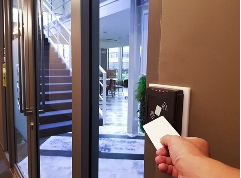SECURITY TECHNOLOGY ADVANCEMENTS
Most up-to-date systems are now using advanced analytics and artificial intelligence (AI) to bring more functionality to access security.
Security technology advancements this decade have often been dominated by the expansion of video-related devices that have evolved with advanced capabilities thanks to enhanced analytics. Over the past year due to the continuing pandemic, the once conventional access control sector has increased its share of advancements. Clients are led into the advancements in artificial intelligence (AI) driven solutions that are speeding the development of cloud integration platforms and a growing list of mobile access control devices, touchless and biometric.
While AI is becoming an integral part of everyday business operations in the security market around the world, security applications have been slower to adopt it into the market. The added health risks companies now face from COVID-19 have forced security providers and users to rethink how AI can help mitigate those risks. There is little argument that AI has the potential to substantially increase the security of exterior and interior entrances as applied in the short term during the crisis, and, while AI will be able to help in many security tasks, such as identifying people from objects at a buildings perimeter and interior entrances, detecting attempted piggybacking, and spotting and analysing potentially lethal objects and dangerous people, AI analytics alone cannot take action to prevent unauthorised human entry or deny the entry of dangerous objects.
AI MIGRATION REQUIRES AN INTEGRATED APPROACH
The migration of security technology to the rapid expansion of security devices means that systems designers and users face the challenge of learning how AI may support entry solutions such as security revolving doors, turnstiles, and access doors. A disconnect between the objectives of the building owner and the architect can further complicate the security blueprint.
Many security entrances do not have AI built into their technology. A successful project that integrates intelligence into secured entrances requires a collaborative effort with a third-party provider. Systems integrators are deploying video analytics into a growing number of applications to address cases such as people and other issues relevant to secured entrances. The increased integration of AI providers with traditional security has resulted in improvements in:
- Speed of entry through the door or lanes
- Ease of use and usability (no badge or fob is needed)
- The use of machine learning to improve algorithms over traditional modelling and correlation approaches (risk profiling)
- Integration with additional systems and sensors

MAKING A PLAN THAT WORKS
It is crucial to understand that many security entrances and mantrap portals often combine several systems, sensors and requirements to effectively mitigate unauthorised entry. Portals, by their nature, prevent tailgating and piggybanking while combining other multiple integrated technologies, such as access control, video surveillance, mechanical hardware, and sensors.
An early example of this integration trend is the addition of cameras located near high-risk entry points, which enables security to tie what took place at an entrance to a corresponding alarm condition such as a forced or jammed entrance/exit. The enhanced capabilities provided by analytics like facial recognition could be used to determine which individuals might have set off the alarm condition. Analytics and other sensors could count the number of people that move through a portal during rush periods in open mode and could also determine that a crowd has gathered, and more doors/portals need to be opened to help the rush in demand for entrance/exit.
The integration of AI into security spaces, not known for their reliance on analytic data, could re-shape the industry. AI can be used as a proactive weapon against intrusion at a security entrance and integrated into access control and video security systems to provide rich analytics and situational awareness.
From a client's perspective, there is an increasing demand, due to COVID 19 pandemic, for touchless access. In this case, the integration of technologies and the use of machine learning can be leveraged to provide efficient, safe and secure access. Machine learning and AI are well adapted to leveraging data sets and, over time, gaining an understanding of conditions and matching them to access control and individual requirements, that the migration to touchless technology has moved beyond simple access control to building automation devices and even touchless computer login. The more that physical security systems adopt standard data types, the more intelligent these systems become, and the more intelligence can be put into predictive analytics.
For more information on AI Integration with physical secured access systems, please contact Chris Stebbing on 01702 713100.
